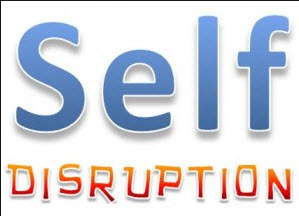 “Why do we always seem to have internal difficulties to self-disrupt?”
“Why do we always seem to have internal difficulties to self-disrupt?”
Now that is an interesting question. My quick and simple answer is to look at all the internal constraints you can see, or ask those around you what they can see as constraints for them. You will be surprised at all the constraints that stop the individual or the organization to make changes.
It is also being constrained when you look outside your organization and not recognizing the (perpetual) changes going on, often until it is too late or a fast, nimble entrepreneur has nipped in and set about building a new alternative to your existing offering that has, perhaps for some time shown signs of business model decay.
In most cases, organizations cannot self-disrupt, which is largely covered by this veritable list of constraints that I see. So I set about thinking what these could be, the bigger inhibitors and here is my rather ‘stark’ list, can you think of any more?
- Organizations often are far too close to existing markets to recognize that they are actually shifting; they ignore or miss the signs in many ways. The famous “death (of a good idea) by a thousand cuts or reviews as it winds itself slowly up to the top and across the flattened hierarchy that believes it is the guardian of the existing.
- They get so fixed on their own perceptions they don’t see change coming – often until it is too late and has lost that intuitive, entrepreneurial touch within the mix.
- They have invested too much, they hang on, often reducing prices, pushing more volume into the markets, and crank out even more “extras” to offset change. Legacy rules, extract the maximum and even extend it!
- Organizations are full of rigidities, rules, procedures, processes and personalities, and often no one is prepared to put their hand up to challenge the present paradigm.
- The reinforcing values are just plain tough to change, you need dynamite to shift these, and under that rubble, you have buried the very nuggets of alternatives that can radically alter thinking.
- The people within organizations love the comfort of the nest they have built around themselves, who wants to bail out and expose themselves? The status quo is very reassuring and comforting.
- The processes become overburdening, hard to change, far too complex to change without significant commitment and top management support. The approval processes are determined by purchasing officers and not the line managers and cost often prevails. Processes grind enthusiasm and experimentation down.
- Cultures are wonderful things to have and determine, that over time get to become the very reasons you become immobilized as you did not evolve constantly. You impact culture by a changing environment or altering the climate. Culture, Climate and the Environment go hand in hand. Mess with one, and the others go out of balance.
- The dark side of fixing your culture and focusing the organization on its purpose and value is they can stifle and constrain far more than promote and let free. As soon as you recognize your culture, it has moved on and evolved.
- Leadership is locked into the strategy, tied into compensation on delivery on the existing, not on the preferred, far more radical, risky alternatives and waits, instead of encouraging small experiments or pilots to learn from.
- Organizations, huge ones are less than nimble, they fail to adapt and respond quickly enough – they prefer to double-down’ with more of the same but faster, leaner and more determined than ever, missing the real dangers occurring under their noses or spend ages coordinating and discussing alternatives, mostly too late.
- Today, we are putting more and more of our organizations into boxes, they are becoming highly structured and specialized in maximising effectiveness and efficiency. Do we ever really ensure all the voices of expertise are in the same room, or do we simply make assumptions that we also really know what the expert knows.
- Markets are more global, faster, fiercer to compete in, often organizations are reluctant to explore and experiment with new business models, or push into adjacencies for fear. They can’t easily spin out or build alternatives as they fear they cannibalise their own business, allowing others to easily pick off valuable areas of new growth.
- Lastly, it does not matter how hard many organizations try, they lack real intelligence in market and customer needs, hence why the jobs-to-be-done is one essential component. They constantly under-invest in knowing the market and listening to their customers.
While all these stays in place, or not recognized as inhibitors to your own disruption capabilities, it is not surprising it is, in the end, those up and coming usurpers, the nimble and unencumbered, that thrive and begin to disrupt. You simply struggle when you leave it to late- your organization needs to resolve many of the above issues before it is ever capable of responding.
Have I missed many of the constraints you are placed under?. Do you think these are the “prime” inhibitors to why your organization seems incapable of self-disrupting?